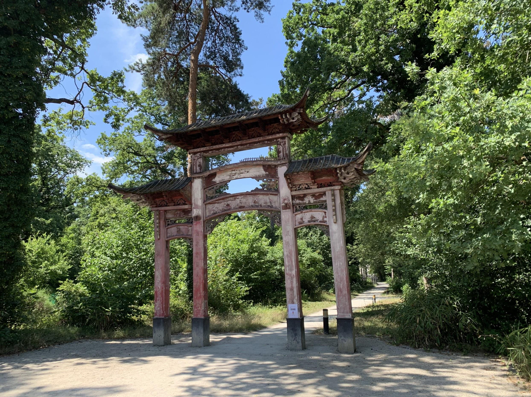By Jason Vu
On the outskirts of Paris to the east of the Bois de Vincennes lies the Jardin d’Agronomie Tropicale (“Garden of Tropical Agriculture”), a historic park dating back to the early 20th century. Rather than the traditional fountains and marble sculptures of Paris’s many other gardens, however, this garden featured Asian and African cultural pieces such as shrines and gateways. It’s not often talked about as a place to visit in the city, but that only made me more determined to go and check it out.

A Chinese gateway greets visitors to the park.
Since classes for my program began late in the afternoon, I decided to go on an adventure on my own to learn more about this hidden garden. Taking the metro there, I eventually arrived in Nogent-sur-Marne, the eastern suburb of Paris where the garden was located. After a brief walk from the metro station, I arrived at the garden and was greeted by a large Chinese gateway.
Coming from a large Asian community in California, the gateway reminded me of many others I had seen back home, but this gateway in Paris was different. Rather than the bright red of traditional gateways, this one seemed faded and worn over time. It gave me the sense that this gateway, as well as the park, was more of a historical site than a place in active use today. The overgrown bushes and lack of many visitors reinforced my assumption.

Courtyard with ceremonial incense burner enclosed by Asian-style wall
Wandering the garden, I soon found panels that helped document the history of the park, albeit only in French. Using my limited reading knowledge in French, I was able to make out that the park was originally the site of France’s 1907 colonial exhibition. The cultural pieces that were spread across the park were originally taken from different parts of the French empire to showcase the “glory of France”. After the exhibition, the park eventually fell into decline with a lack of upkeep until 2006 when the city of Paris reopened the park.

Maison Cochinchinoise, dedicated to Indochinese soldiers who fought for France.
Continuing through the park, I eventually found myself in front of a small temple-like structure that I later learned was dedicated to Indochinese soldiers who died in battle for France. The monument was small but once again, I was reminded of temples back home that were dedicated to deceased relatives and ancestors. I decided to rest near this shrine for a little while before continuing on my way.

The Indochina Pavillion
The last place I had a chance to stop at in the garden was a museum-like structure with the word “Indochine” at the very top. Signs nearby said that the building was originally an indoor exhibition of objects from around the Indochina region. Although the pavillion was now abandoned, I wandered around for a while before it was eventually time for me to head to class.
As I made my way back to the metro station, I continued to think about the old garden. Most tourist spots in Paris are often crowded and busy, but this place was special because of how calm and peaceful it was. Perhaps its location or its lack of notoriety keeps it so quiet, but in the midst of the busy city, it’s always nice to have a place to escape to for just a while.
Jason studied abroad in France in Summer 2019. https://ieo.ucla.edu/travelstudy/GlobalStudies-France/



